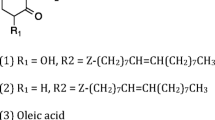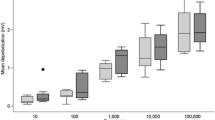Abstract
Chemoorientation behavior of the larval eastern tent caterpillar,Malacosoma americanum, was studied using the synthetic trail pheromone 5β-cholestane-3,24-dione. Divergent arms of Y mazes were treated with various concentration ratios of the pheromone. At application rates of 10−10-10−9 g/mm of trail, larvae showed a significant preference for stronger trails when concentration ratios differed by as little as 4:1. At application rates of 10−8 and greater there was no significant difference in trail choice even when trails differed in strength by a full order of magnitude. Other studies showed that the caterpillars abandon the pattern of choosing stronger over weaker trails when they repeatedly fail to find food at the end of a stronger trail. Experiments in which larvae were required to choose trails separated by a gap demonstrated orientation by chemoklinotaxis. Caterpillars that had one of the maxillary palps ablated looped in the direction of their intact chemo-receptor when placed on filter paper treated uniformly with pheromone, indicating that they may also orient by tropotaxis. The relevance of these findings to the tent caterpillar communication system is discussed.
Similar content being viewed by others
References
Bell, W.J. 1984. Chemo-orientation in walking insects, pp. 93–109,in W.J. Bell and R.T. Cardé (eds.). Chemical Ecology of Insects. Chapman and Hall, New York.
Bell, W.J., andTobin, T.R. 1982. Chemo-orientation.Biol. Rev. 57:219–260.
Crump, D., Silverstein, R.M., Williams, H.J., andFitzgerald, T.D. 1987. Identification of trail pheromone of larva of eastern tent caterpillarMalacosoma americanum (Lepidoptera: Lasiocampidae).J. Chem. Ecol. 13:397–402.
Fitzgerald, T.D. 1976. Trail marking by larvae of the eastern tent caterpillar.Science 194:961–963.
Fitzgerald, T.D., andEdgerly, J. 1982. Site of secretion of the trail marker of the eastern tent caterpillar.J. Chem. Ecol. 8:31–39.
Fitzgerald, T.D., andGallagher, E. 1976. A Chemical trail factor from the silk of the eastern tent caterpillarMalacosoma americanum (Lepidoptera: Lasiocampidae).J. Chem. Ecol. 2:187–193.
Fitzgerald, T.D., andPeterson, S.C. 1983. Elective recruitment by the eastern tent caterpillar (Malacosoma americanum).Anim. Behav. 31:417–423.
Fitzgerald, T.D., andPeterson, S.C. 1988. Cooperative foraging and communication in caterpillars.BioScience 38:20–25.
Hangartner, W. 1967. Spezifität und Inaktivierung des Spurpheromons vonLasius fuliginosus Latr. und Orientierung der Arbeiterinnen im Duftfeld.Z. Vergl. Physiol. 57:103–136.
Kennedy, J.S. 1986. Some current issues in orientation to odour sources, pp. 11–25,in T.L. Payne, M.C. Birch, and C.E.J. Kennedy (eds.). Mechanisms in Insect Olfaction. Oxford University Press, New York.
Peterson, S.C. 1988. Chemical trail marking and following by caterpillars ofMalacosoma neustria.J. Chem. Ecol. 14:815–824.
Roessingh, P., Peterson, S.C., andFitzgerald, T.D. 1988. The sensory basis of trail following in some lepidopterous larvae: Contact chemoreception.Physiol. Entomol. 13:219–224.
Schal, C., Tobin, T.R., Surber, J.L., Vogel, G., Tourtellot, M.K., Leban, R.A., Sizemore, R., andBell, W.J. 1983. Search strategy of sex pheromone-stimulated male German cockroaches.J. Insect Physiol. 29:575–579.
Schöne, H. 1984. Spatial Orientation: The Spatial Control of Behavior in Animals and Man. Princeton University Press, Princeton, New Jersey.
Schoonhoven, L.M. 1987. What makes a caterpillar eat? The sensory code underlying feeding behavior, pp. 69–97,in R.F. Chapman, E.A. Bernays, and J.G. Stoffolano (eds.). Perspectives in Chemoreception and Behavior. Springer-Verlag, New York.
Wilson, E.O. 1971. The Insect Societies. Harvard University Press, Cambridge, Massachusetts.
Author information
Authors and Affiliations
Rights and permissions
About this article
Cite this article
Peterson, S.C., Fitzgerald, T.D. Chemoorientation of eastern tent caterpillars to trail pheromone, 5β-Cholestane-3,24-dione. J Chem Ecol 17, 1963–1972 (1991). https://doi.org/10.1007/BF00992581
Received:
Accepted:
Issue Date:
DOI: https://doi.org/10.1007/BF00992581




